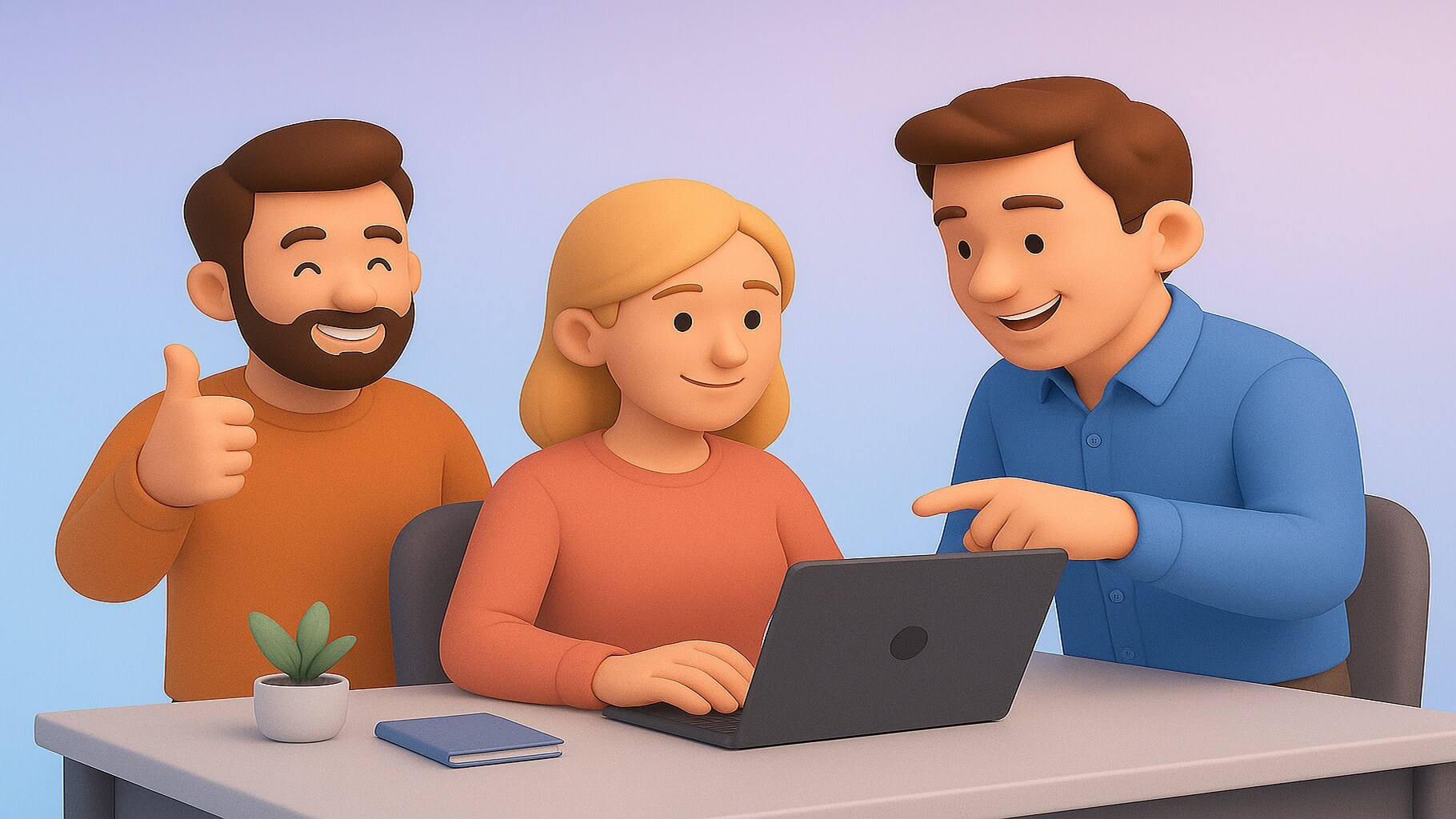
Today's workplace demands leaders who can navigate increasingly complex team dynamics while maintaining productivity and morale. Whether you're facing communication breakdowns between team members, struggling with remote collaboration, or dealing with conflicts that threaten team cohesion, knowing how to handle team challenges effectively can distinguish between a flourishing organization and one that simply endures. At Matter, we understand that these obstacles aren't just temporary inconveniences. They're critical moments that shape your team's future success. From the subtle erosion of trust that happens when deadlines slip to the explosive conflicts that can derail entire projects, team challenges manifest in countless ways that test even the most experienced leaders.
This comprehensive guide provides actionable strategies for transforming workplace obstacles into opportunities for growth, offering proven methods to address everything from virtual team dynamics across time zones to the personality clashes that occur when diverse individuals collaborate under pressure. By mastering how to handle team challenges proactively, you'll build stronger, more resilient teams that don't just overcome obstacles but use them as stepping stones to reach new levels of performance and innovation.
What are team challenges and why do they matter?

Team challenges represent the various obstacles that prevent groups from achieving their full potential and maintaining effective teamwork. These issues range from minor miscommunications to major conflicts that can derail entire projects and damage team morale. Understanding and addressing these challenges matters because unresolved problems compound over time, creating toxic environments where valuable employees disengage and productivity plummets. Organizations that proactively manage challenges gain competitive advantages through improved innovation, stronger retention, and the ability to adapt quickly to changing market conditions.
Understanding what the challenges of teamwork are
The challenges of teamwork emerge when individuals with different backgrounds, communication styles, and work preferences must collaborate toward common goals. As team members transition from independent work to collaborative environments, they often struggle with role clarity and understanding how their contributions fit into the bigger picture. This confusion intensifies when personality clashes arise between individuals who have their own preferences for completing tasks, leading to friction that undermines team collaboration.
Human resource management professionals identify several core teamwork obstacles:
- Role ambiguity that prevents team members from fully understanding their responsibilities
- Poor self-awareness limiting individuals' ability to recognize their impact on others
- Skill gaps that create imbalances in workload distribution and quality
- Conflicting priorities between departments or team goals
- Technology barriers that hinder smooth collaboration
Successfully addressing these fundamental challenges requires more than generic solutions. Organizations that implement structured team-building activities create opportunities for team members to develop better self-awareness while learning to appreciate diverse working styles. These activities help establish clear expectations for collaboration and build the personal bonds necessary for overcoming future obstacles together.
Common team challenges that impact productivity
When teams face persistent obstacles, team productivity suffers as energy gets diverted from core objectives to managing interpersonal conflicts or navigating inefficient processes. Inadequate communication emerges as the principal cause, manifesting in missed deadlines, duplicated efforts, and frustrated team members who feel their valuable insights go unheard. These issues multiply in organizations lacking systems to track progress effectively, leading to confusion about priorities and wasted team effort on low-impact activities.
Critical productivity challenges include:
- Information silos preventing knowledge sharing across departments
- Meeting overload that consumes time without producing clear outcomes
- Unclear priorities causing teams to focus on the wrong objectives
- Process inefficiencies creating unnecessary friction in workflows
- Burnout from sustained pressure without recognition or support
These challenges have an effect that is not limited to instantaneous productivity losses. When teams consistently struggle with poor cooperation between departments or unclear team goals, it creates work-related resentment that poisons the work culture. Leaders must establish systems that help teams overcome challenges systematically, using tools and processes that surface issues early. Regular check-ins that facilitate important conversations ensure problems get addressed before they escalate, while virtual team challenges require additional consideration for remote collaboration dynamics.
Why learning how to handle team challenges drives success
Organizations that excel at challenge management create environments where innovation thrives because team members feel empowered to express thoughts openly without apprehension of criticism or retribution. When leaders demonstrate they can resolve disagreements constructively while maintaining psychological safety, it encourages calculated risk-taking and creative problem-solving. This approach transforms potential conflicts into catalysts for growth, building resilience that helps teams navigate future obstacles more effectively.
The benefits of mastering challenge management extend throughout the organization:
- Enhanced innovation through diverse perspectives and constructive conflict
- Stronger engagement when employees see challenges addressed proactively
- Improved retention as current employees value supportive environments
- Better customer outcomes from seamless internal collaboration
- Increased profitability through reduced friction and higher output
Building a successful team requires combining reactive problem-solving capabilities with proactive culture development. Leaders who invest in teaching their teams how to handle team challenges position themselves for sustained success. The most effective approaches focus on developing collective problem-solving skills rather than relying on individual heroes to save the day.
8 common team challenges and their solutions

Every team encounters obstacles, but organizations that develop systematic approaches for addressing common challenges build stronger, more capable teams over time. Understanding these typical issues while implementing proven solutions helps leaders maintain team performance even during difficult periods. The key lies in addressing root causes rather than symptoms while empowering team members to develop independent problem-solving capabilities that strengthen the entire team.
Communication breakdowns and how to fix them
Poor communication undermines even the most talented teams, creating cascading failures that impact professional performance across entire organizations. When team members operate with different information or misunderstand expectations, the resulting confusion leads to duplicated efforts, missed opportunities, and growing frustration. These breakdowns become particularly damaging in fast-paced environments where quick decision-making and coordinated action determine success.
Targeted solutions for communication failures:
- Implement group messaging software with channel hierarchies for different urgency levels
- Create communication heat maps identifying where information gets stuck or lost
- Establish "communication champions" in each department to bridge gaps
- Design message templates for common scenarios to ensure consistency
- Institute "no meeting Fridays" to allow deep work and asynchronous communication
The key to fixing communication issues lies in creating structured pathways that match message types with appropriate channels. Teams practicing with fun team challenges that require precise information exchange develop better communication habits in low-pressure environments. When team members understand exactly how and when to communicate different types of information, misunderstandings decrease dramatically.
Conflict resolution strategies for team challenges examples
Workplace conflicts arise naturally when diverse personalities collaborate under pressure, but these disagreements can strengthen teams when channeled productively. Rather than avoiding conflict, successful teams learn to harness disagreement as a tool for innovation and improvement. The challenge lies in preventing conflicts from becoming personal while maintaining the productive tension that drives creative solutions.
Advanced conflict transformation techniques:
- Implement "conflict protocols" that outline escalation paths before emotions run high
- Create "perspective-taking exercises" where team members argue opposing viewpoints
- Establish conflict mentors who guide teams through difficult conversations
- Use structured debate formats for contentious decisions requiring multiple viewpoints
- Develop "conflict currencies" that track and reward productive disagreements
Transforming conflict into a positive force requires shifting team mindsets about disagreement. Through structured team-building activities that deliberately introduce controlled conflict scenarios, teams learn that disagreement can strengthen rather than weaken their collective capabilities. The goal isn't eliminating conflict but channeling it toward productive outcomes.
Trust issues and rebuilding team cohesion
Trust erosion happens gradually through small betrayals like missed deadlines, broken promises, or inconsistent behavior until team collaboration becomes purely transactional. Unlike communication problems that manifest immediately, trust issues often simmer beneath the surface, undermining team effectiveness in subtle ways. Rebuilding trust requires deliberate actions that demonstrate reliability over extended periods.
Innovative solutions for trust-building strategies:
- Implement "trust contracts" where team members explicitly state commitments
- Create vulnerability exercises where leaders share failures and lessons learned
- Establish "trust metrics" tracking follow-through rates on commitments
- Design collaborative challenges requiring mutual dependence for success
- Institute "trust repair protocols" for addressing breaches quickly and fairly
Building trust through shared experiences proves more effective than traditional team-building activities. Creative office challenges that require teams to depend on each other in meaningful ways accelerate trust development. When team members consistently experience colleagues following through on commitments, confidence in the entire team's reliability grows exponentially.
Managing resistance to change
Change resistance represents one of the most persistent team challenges, particularly in established organizations where the status quo feels comfortable. Team members resist change for various reasons, including fear of the unknown, concern about job security, or simple preference for familiar processes. This resistance can derail even well-planned initiatives if not addressed proactively.
Strategies for overcoming change resistance:
- Create "change ambassadors" from influential team members who model adaptation
- Implement gradual rollouts allowing teams to adjust incrementally
- Establish "innovation time" where experimenting with new approaches is encouraged
- Develop change narratives connecting new initiatives to team values
- Provide "safety nets" ensuring mistakes during transition won't have severe consequences
Successfully managing change requires understanding that resistance often stems from legitimate concerns rather than stubbornness. By providing necessary encouragement and support during transitions, leaders help teams navigate uncertainty while maintaining productivity and morale.
Addressing skill gaps and knowledge silos
Skill gaps create frustration when team members lack capabilities needed for evolving responsibilities, while knowledge silos prevent effective collaboration across departments. These challenges often intersect, as specialists hoard knowledge to maintain their value, creating dependencies that slow entire teams. Modern organizations must balance specialization with knowledge sharing to maintain agility.
Solutions for capability development:
- Implement "skill swapping" sessions where team members teach each other
- Create knowledge repositories accessible to all team members
- Establish mentorship rotations pairing experts with learners across departments
- Design cross-training programs ensuring critical skills have backup coverage
- Institute "documentation days" dedicated to capturing institutional knowledge
Addressing skill gaps requires more than traditional training programs. Teams participating in workplace wellness challenges often discover hidden talents and interests that can be developed into valuable team capabilities. This organic approach to skill development creates more engaged learners and better knowledge retention.
Overcoming accountability issues
A domino effect of missed deadlines and finger-pointing is initiated when team members neglect to assume responsibility for their duties. Accountability issues often stem from unclear expectations, fear of failure, or lack of consequences for poor performance. Building a culture of accountability requires systems that make ownership clear while supporting team members in meeting their commitments.
Accountability enhancement strategies:
- Implement public commitment boards where team members post their deliverables
- Create peer accountability partnerships for mutual support and pressure
- Establish clear consequence frameworks that are fair and consistently applied
- Design recognition systems celebrating those who consistently deliver
- Institute regular "accountability audits" reviewing commitment follow-through
True accountability develops when team members feel ownership over outcomes rather than just tasks. This shift in mindset transforms how teams approach their work and support each other in achieving collective goals.
Resolving decision-making bottlenecks
Decision paralysis occurs when teams lack clear authority structures or when fear of making wrong choices prevents action. These bottlenecks frustrate team members who see opportunities slipping away while waiting for approvals or consensus. Effective teams need decision-making frameworks that balance speed with quality while ensuring appropriate stakeholder input.
Decision optimization techniques:
- Create decision matrices clarifying who decides what at various levels
- Implement "RAPID" frameworks defining roles in each decision type
- Establish decision deadlines preventing endless deliberation
- Design escalation triggers for when decisions exceed team authority
- Institute "decision retrospectives" learning from both good and bad choices
Empowering teams to make decisions within defined parameters accelerates progress while building confidence. When team members understand their decision-making authority and have frameworks for exercising it, organizations become more agile and responsive.
Tackling motivation and engagement drops
Engagement fluctuates naturally, but sustained drops in motivation signal deeper issues requiring attention. When entire teams experience decreased morale simultaneously, it often indicates systemic problems rather than individual issues. Leaders must diagnose root causes quickly while implementing both immediate relief and long-term solutions.
Motivation restoration approaches:
- Conduct "energy audits," identifying what drains versus energizes teams
- Implement "purpose reconnection" sessions linking daily work to larger missions
- Create "small wins" programs celebrating incremental progress
- Design autonomy experiments giving teams more control over their work
- Establish "motivation mentors" who help colleagues rediscover their drive
Sustainable motivation comes from intrinsic factors rather than external rewards alone. By helping team members connect their work to personal values and goals, leaders create more resilient engagement that withstands temporary setbacks.
How to overcome challenges of virtual teams

Remote and hybrid work arrangements have become permanent fixtures in the modern workplace, introducing unique obstacles that require innovative management approaches. Virtual teams face additional complexity beyond traditional challenges, including technology barriers, time zone differences, and the absence of informal interactions that typically help relationships form naturally. Success in managing distributed teams demands intentional strategies that bridge physical distances while maintaining the strong connections necessary for effective team collaboration.
Technology and connectivity obstacles
Technical challenges can derail virtual team productivity faster than any other factor, creating frustration that compounds existing communication difficulties. When team members struggle with unreliable internet connections, incompatible software systems, or inadequate training on collaboration tools, even simple tasks become arduous. Organizations must prioritize technology infrastructure and support as foundational elements enabling virtual collaboration.
Comprehensive technology solutions:
- Deploy redundant connectivity options including mobile hotspot backups
- Standardize hardware specifications ensuring consistent performance across teams
- Create tech buddy systems pairing technically proficient members with those needing support
- Implement asynchronous-first tools reducing dependency on real-time connections
- Establish virtual IT help desks with screen-sharing capabilities for immediate assistance
Beyond basic connectivity, successful virtual teams need integrated ecosystems that simplify rather than complicate workflows. Addressing remote team challenges requires selecting tools based on user experience and accessibility rather than feature lists. The goal is technology that becomes invisible, supporting work without becoming the focus of attention.
Building engagement across remote team members
Maintaining engagement without physical proximity requires replacing spontaneous office interactions with intentional connection points. Virtual teams miss the casual conversations that build relationships and the visual cues that help team members understand each other's workload and emotional state. Without deliberate intervention, remote workers often feel isolated from their team's vision and struggle to maintain motivation.
Innovative remote engagement tactics:
- Create "virtual office hours" where team members can drop in for informal chats
- Implement "buddy systems" pairing remote workers for regular check-ins
- Design "show and tell" sessions where team members share personal interests
- Establish "virtual lunch clubs" with rotating conversation topics
- Institute "recognition rituals" ensuring remote contributions gain visibility
Successful remote engagement strategies go beyond replicating office experiences online. Teams participating in specially designed employee wellness challenges build connections through shared health goals while developing accountability partnerships that strengthen working relationships. These initiatives create multiple touchpoints throughout the workweek, helping remote workers feel genuinely connected to colleagues.
Time zone and cultural disparities in virtual teams
Global teams bring invaluable diversity of thought and round-the-clock productivity capabilities, but they also introduce complexity around scheduling and cultural understanding. Different communication styles, work preferences, and cultural norms can create misunderstandings that undermine team collaboration efforts. These challenges multiply when teams span multiple time zones, potentially excluding some team members from important conversations.
Global team optimization strategies:
- Implement "follow-the-sun" workflows that maximize time zone coverage
- Create cultural liaison roles helping teams navigate different norms
- Establish "core hours" when all time zones overlap for critical meetings
- Design cultural exchange programs to deepen cross-cultural understanding
- Institute "asynchronous ceremonies" allowing participation across time zones
Success with global teams requires embracing asynchronous work as the default rather than the exception. When teams learn to leverage time zone differences as an advantage, enabling continuous progress on projects, they often outperform co-located teams in both productivity and innovation.
7 strategies for how to challenge your team positively
Creating environments where challenges inspire growth rather than frustration requires thoughtful leadership and strategic planning. Positive challenges differ from overwhelming obstacles by providing clear paths to success while stretching capabilities beyond current comfort zones. When implemented effectively, these strategies help teams develop new skills, strengthen collaboration, and achieve ambitious goals they initially thought impossible.
Setting stretch goals that inspire growth
Smart goals that push teams beyond current capabilities create optimal conditions for development when balanced with achievable milestones. The most effective stretch objectives emerge from collaborative planning where team members contribute to defining ambitious yet realistic targets. This participatory approach ensures buy-in while building shared understanding of what success requires.
Advanced goal-setting strategies:
- Implement "moonshot sessions" where teams imagine breakthrough achievements
- Create goal cascades linking individual contributions to team objectives
- Design "progress thermometers" making advancement visible to all
- Establish learning goals alongside performance targets
- Institute "pivot points" allowing goal adjustment based on new learning
Stretch goals become powerful motivators when connected to meaningful outcomes that team members care about personally. Incorporating workplace fitness challenges as team-wide objectives demonstrates how shared goals requiring consistent team effort can improve both individual health and collective cohesion.
Creating healthy competition within teams
Competition channeled constructively drives excellence without damaging relationships or creating destructive rivalries. The key lies in designing competitive elements that encourage cooperation within competitive frameworks while recognizing both effort and achievement. Healthy competition energizes teams when it celebrates diverse strengths rather than creating single winners and multiple losers.
Constructive competition frameworks:
- Design "tournament trees" where everyone advances through different skill brackets
- Create rotating competitions highlighting different team member strengths weekly
- Implement point systems that reward collaboration within competition
- Establish team challenges where groups compete while individuals cooperate
- Institute "competition sabbaticals" to prevent burnout from constant rivalry
Well-structured competitive elements tap into natural human drives while maintaining team cohesion. Programs like office fitness challenges demonstrate how competition can motivate positive behaviors. Teams might compete on aggregate step counts while supporting individual members struggling to meet personal goals.
Encouraging innovation through constructive challenges
Innovation flourishes when teams face problems requiring creative solutions rather than standard approaches. By presenting challenges without predetermined solutions, leaders unlock their teams' creative potential and encourage fresh thinking. These innovation challenges are most effective when connected to real business problems or customer needs, providing teams with clear motivation to find breakthrough solutions.
Innovation catalyst techniques:
- Host "impossible challenges" forcing radical rethinking of approaches
- Create innovation tournaments with multiple solution paths
- Implement "fast failure" competitions celebrating quick learning
- Design constraint challenges forcing creativity within tight parameters
- Establish innovation partnerships pairing unlikely collaborators
Providing safe spaces for experimentation while maintaining accountability for learning (not just success) creates optimal conditions for breakthrough thinking. Regular employee engagement challenges focused on innovation help normalize creative risk-taking as an expected part of team culture rather than an exceptional occurrence.
Implementing peer learning initiatives
Peer learning leverages existing team knowledge while building stronger connections between team members. Unlike traditional training, where experts lecture novices, peer learning creates reciprocal relationships where everyone teaches and learns. This approach develops both technical skills and the communication abilities necessary for effective knowledge transfer.
Peer learning optimization strategies:
- Create "teach-back Tuesdays" where team members share recent learnings
- Implement skill exchanges where members trade expertise
- Design peer mentoring circles for ongoing development support
- Establish documentation partnerships for capturing tacit knowledge
- Institute "failure forums" where teams share lessons from mistakes
Effective peer learning requires creating psychological safety where team members feel comfortable admitting knowledge gaps. This vulnerability, when met with support rather than judgment, accelerates both individual and collective capability development.
Developing cross-functional expertise
Breaking down silos requires deliberately exposing team members to challenges outside their primary expertise. Cross-functional development creates more versatile teams capable of understanding how their work impacts other departments. This broader perspective improves collaboration while creating backup capabilities for critical functions.
Cross-functional development approaches:
- Implement rotation programs giving team members temporary assignments
- Create shadow programs where employees observe other departments
- Design collaborative projects requiring diverse expertise
- Establish cross-functional task forces for specific challenges
- Institute "perspective days" where teams experience other roles
Building cross-functional expertise through hands-on challenges proves more effective than theoretical training. When team members directly experience the challenges faced by other departments, they develop empathy and understanding that improves future collaboration.
Fostering leadership at all levels
Traditional hierarchies often limit leadership development to designated managers, missing opportunities to cultivate leadership capabilities throughout the entire team. By creating challenges that require different team members to step into leadership roles, organizations develop deeper bench strength while improving overall team performance.
Distributed leadership strategies:
- Rotate project leadership giving everyone opportunities to lead
- Create "micro-leadership" roles for specific competencies
- Implement peer coaching programs to develop leadership skills
- Design leadership challenges testing different aspects of leadership
- Establish leadership shadowing for experiential learning
When team members experience leadership challenges firsthand, they develop an appreciation for the complexities involved while building confidence in their own capabilities. This distributed approach creates more resilient teams capable of adapting when formal leaders are unavailable.
Building resilience through progressive challenges
Resilience develops through successfully navigating increasingly difficult challenges rather than avoiding obstacles altogether. Teams that practice overcoming smaller challenges build confidence and skills necessary for handling major crises. This progressive approach prevents overwhelming teams while systematically building their capacity for handling adversity.
Progressive resilience building:
- Design challenge ladders with increasing difficulty levels
- Create recovery protocols teaching teams to bounce back quickly
- Implement stress inoculation through controlled challenging situations
- Establish support systems for teams facing difficult challenges
- Institute celebration rituals recognizing resilience alongside success
Building resilience requires balancing challenge with support, ensuring teams stretch without breaking. When teams successfully navigate progressively difficult challenges, they develop confidence in their collective ability to handle whatever future obstacles arise.
Proactive approaches to prevent team challenges

Prevention proves far more effective and less costly than reactive problem-solving when managing team dynamics. Proactive strategies build resilience directly into team structures, reducing both the frequency and severity of challenges that inevitably arise. Organizations that invest in preventive measures strengthen their team foundations before problems emerge, maintaining momentum toward strategic objectives while avoiding costly disruptions.
Building strong team foundations from day one
Initial team formation sets trajectories that determine future success or struggle, making early investments critical for long-term performance. New employees joining established teams need structured onboarding that goes beyond policy explanations to include cultural immersion and relationship building. Similarly, newly formed teams require intentional design of their operating agreements and dedicated time for establishing trust.
Comprehensive foundation-building elements:
- Design immersive onboarding experiences including job shadowing and mentorship
- Create team manifestos articulating shared values and working principles
- Implement role negotiation sessions that ensure clear responsibility distribution
- Establish communication covenants defining how teams will interact
- Institute early warning systems for identifying potential friction points
Strong foundations require moving beyond traditional icebreakers to foster meaningful relationships. Strategic, fun office challenges during formation phases serve multiple purposes. They help members discover each other's strengths while establishing positive interaction patterns. When teams invest time in building strong foundations, they create reserves of goodwill that help them weather future storms.
Regular team health checks and assessments
Continuous monitoring prevents small issues from escalating into major crises while providing valuable insights into the evolution of team dynamics. Regular health checks serve as early warning systems, identifying emerging challenges before they significantly impact performance. This proactive approach also celebrates successes, reinforcing positive behaviors and effective strategies that should be maintained or expanded.
Multi-dimensional assessment strategies:
- Deploy pulse surveys with rotating focus areas for comprehensive coverage
- Conduct stay interviews understanding why valuable team members remain
- Implement peer feedback systems for horizontal performance insights
- Create team dashboards visualizing key health metrics in real-time
- Establish assessment rhythms balancing insight gathering with survey fatigue
Making assessments routine normalizes continuous improvement while reducing anxiety around evaluation. When teams see assessments as tools for their development rather than judgment mechanisms, they engage more honestly and benefit more fully from the insights generated.
Creating clear processes and expectations
Ambiguity breeds dysfunction as team members waste energy trying to understand how work should flow between roles. Clear processes provide roadmaps for collaboration while maintaining enough flexibility for teams to adapt to changing circumstances. The task is to establish a framework that facilitates rather than hinders team performance.
Process clarity optimization techniques:
- Map value streams showing how work flows through teams
- Create RACI matrices clarifying responsibility distributions
- Implement process wikis allowing teams to document and update procedures
- Design exception protocols for handling non-standard situations
- Establish feedback loops for continuous process improvement
Well-designed processes become enablers rather than obstacles when teams understand both the what and why behind procedures. Incorporating structured team-building activities like office exercise challenges into regular routines helps teams practice following processes in enjoyable contexts, building habits that transfer to work situations.
Leadership tactics for handling team challenges

Effective leadership distinguishes teams that crumble under pressure from those that emerge stronger in the face of adversity. Modern leaders must balance multiple approaches, knowing when direct intervention helps versus when empowerment better serves team development. This flexibility, combined with emotional intelligence and genuine care for team members, enables leaders to guide groups through challenges while building long-term resilience.
When to intervene vs. letting teams self-
Determining appropriate intervention levels requires nuanced judgment developed through experience and careful observation. Leaders must resist both micromanagement tendencies that stifle growth and hands-off approaches that abandon teams when they need support. The most effective approach creates frameworks that empower independent problem-solving while ensuring help remains available when genuinely needed.
Intervention decision framework:
- Assess impact severity using predefined escalation criteria
- Evaluate team readiness through capability maturity models
- Consider learning value against potential negative consequences
- Monitor stress indicators intervening before team burnout
- Provide graduated support increasing involvement only as needed
Creating environments where teams confidently address challenges requires practice opportunities with appropriate safety nets. Implementing team workout challenges helps teams develop collaborative problem-solving muscles in low-stakes situations. As teams successfully navigate increasingly complex challenges independently, they build confidence and capabilities for handling real workplace situations.
Coaching techniques for team development
Modern leadership emphasizes coaching over commanding, focusing on developing team capabilities rather than providing solutions. This developmental approach creates sustainable improvements by building internal capacity for ongoing problem-solving. Effective coaching requires patience and genuine investment in team member growth while balancing immediate performance needs with longer-term development.
Advanced coaching methodologies:
- Implement situational coaching adapting the style to individual readiness levels
- Use appreciative inquiry focusing on strengths and successes
- Deploy systemic coaching addressing team dynamics beyond individuals
- Create coaching cultures where peer coaching supplements leader coaching
- Establish coaching metrics tracking development progress over time
The most impactful coaching occurs through regular informal interactions rather than scheduled sessions. Leaders who naturally integrate coaching into their daily operations create cultures where continuous learning is embedded in how teams operate, benefiting both individual careers and organizational capabilities.
Building psychological safety in challenging times
Psychological safety represents team members' belief that they can take risks without facing punishment or humiliation. This foundation becomes critical during challenging periods. Without psychological safety, teams cannot engage in honest communication necessary for addressing problems effectively. Building this safety requires consistent leadership behaviors that demonstrate genuine care for team members as whole people, not just producers of work.
Psychological safety building blocks:
- Model fallibility by admitting mistakes and uncertainties openly
- Respond positively to bad news and dissenting opinions
- Protect risk-takers even when experiments fail
- Ask genuine questions showing curiosity rather than judgment
- Share decision-making power when appropriate
Building psychologically safe environments takes time and consistent effort but yields significant returns. Supporting initiatives like employee fitness challenges provides opportunities for teams to practice vulnerability in non-work contexts. Admitting fitness struggles or asking for support transfers to greater openness in work situations.
How Matter transforms team challenge management
Modern organizations need sophisticated tools addressing complex team challenges while fostering positive workplace cultures. Matter provides comprehensive solutions, transforming how teams communicate, recognize achievements, and build the resilience necessary for overcoming any obstacle. By integrating seamlessly with Slack and Microsoft Teams, Matter embeds positive practices directly into daily workflows rather than adding another platform to manage.
Using recognition to prevent common team challenges
Recognition serves as powerful preventive medicine against team dysfunction, building trust and improving morale before problems take root. When team members consistently acknowledge each other's contributions through Matter's platform, it creates positive dynamics resistant to negative patterns. The system makes recognition simple and meaningful, ensuring achievements don't go unnoticed while reinforcing behaviors supporting the team's vision.
Matter's preventive recognition features:
- Value-aligned kudos cards reinforcing desired behaviors consistently
- Peer recognition analytics identifying potential relationship issues early
- Automated celebration triggers ensuring milestones get acknowledged
- Recognition leaderboards gamifying appreciation without creating competition
- Feedback Friday automation building consistent recognition habits
Making recognition frequent and specific helps teams develop stronger bonds while clarifying performance expectations. When implemented thoughtfully, recognition systems address multiple team challenges simultaneously. They improve communication, build trust, and increase engagement through positive reinforcement.
Real-time feedback tools for addressing issues early
Early detection prevents minor irritations from becoming major disruptions requiring extensive intervention. Matter's feedback mechanisms create continuous dialogue channels where concerns surface naturally through regular interaction. This proactive approach to managing employee challenges transforms potential problems into opportunities while maintaining positive dynamics.
Advanced feedback capabilities:
- Sentiment analysis identifying concerning trends automatically
- Anonymous channels for sensitive topic discussions
- Custom survey builders addressing specific team concerns quickly
- Integration with workflow tools meeting teams where they work
- Predictive analytics flagging potential issues before they manifest
Combining structured and informal feedback mechanisms ensures comprehensive coverage without creating assessment fatigue. This balanced approach maintains engagement while providing actionable insights for continuous improvement across all team performance dimensions.
Building resilient teams through continuous appreciation
Resilience develops through consistent positive experiences, building confidence over time. Matter facilitates this by making appreciation and constructive feedback integral to team culture. When teams regularly celebrate successes while learning from setbacks together, they develop a collective strength to weather future challenges.
Resilience-building features:
- Progress tracking showing team growth over time
- Challenge frameworks building problem-solving capabilities
- Cross-functional recognition breaking down organizational silos
- Reward flexibility motivating diverse team members effectively
- Cultural reinforcement tools embedding values into daily operations
This systematic approach creates sustainable cultures where challenges become opportunities for demonstrating capabilities. Matter's comprehensive features address immediate needs while fostering long-term cultural development essential for organizational success in dynamic environments.
FAQs about handling team challenges
Quick solutions for urgent team issues
Q: How should I handle conflict that erupts during important team meetings?
A: Immediately pause the discussion and acknowledge emotions without taking sides. Call a brief break if tensions are high, then reconvene with ground rules for respectful dialogue. Focus on understanding each perspective through active listening before seeking solutions. Sometimes, scheduling a private conversation afterward can resolve issues that public discussion cannot, especially when deeper problems require individual attention.
Q: What's the fastest way to address sudden drops in team productivity?
A: Start gathering data through quick pulse surveys to understand root causes affecting your entire team. Look for external factors, such as new processes that create problems or increased workloads that overwhelm team members. While investigating deeper issues, provide immediate relief by adjusting assignments or organizing meetings differently to boost morale and demonstrate responsiveness to team concerns.
Q: How do I respond when key team members threaten to leave?
A: Schedule an immediate private meeting focused on understanding their concerns completely. Practice genuine listening without defensiveness, exploring what changes might address their issues. If retention isn't feasible, shift focus to knowledge transfer and team preparation while maintaining professionalism. Request assistance from HR early to ensure smooth transitions that minimize productivity loss.
Resources for ongoing team development
Q: Which activities work best for geographically distributed teams?
A: Virtual escape rooms requiring genuine teamwork prove highly effective, as do collaborative online games that encourage team members to work together. Regular virtual coffee sessions help personal bonds form naturally across distances. Select team-building activities that accommodate diverse time zones and technical capabilities, ensuring everyone can participate fully, regardless of their location or comfort level with technology.
Q: How often should teams conduct performance assessments?
A: Replace annual reviews with quarterly check-ins supplemented by monthly pulse surveys to track progress continuously. Add weekly one-on-ones for addressing immediate concerns before they escalate. This frequent feedback approach prevents surprises while maintaining development focus. Use technology to streamline data collection, avoiding assessment fatigue that can undermine the valuable insights these tools provide.
Q: What training investments yield the highest returns?
A: Communication skills, emotional intelligence, and problem-solving capabilities typically generate maximum impact because they address fundamental team dynamics. While technical competencies are important, interpersonal skills determine whether teams can contribute effectively together. Invest in programs that combine theory with practical application, enabling teams to immediately practice new skills in their actual work environment.
Best practices for different team sizes and types
Q: How do management strategies differ between small and large teams?
A: Small teams benefit from informal communication and flexible roles, enabling quick adaptation, while larger teams require structured processes to maintain coordination. Keep sub-teams under eight members within larger structures to preserve agility. Utilize technology to scale successful small-team practices, maintaining the intimacy and trust that characterize high-performing groups, regardless of their overall size.
Q: What special considerations apply to cross-functional teams?
A: Cross-functional teams often struggle with competing departmental priorities and clashing cultural norms. Address these by creating clear project charters defining authority explicitly. Establish neutral collaboration spaces where departmental politics don't dominate discussions. Regular alignment sessions prevent objectives from diverging while ensuring all departments remain committed to shared goals throughout project lifecycles.
Q: How should creative teams approach challenges differently?
A: Creative teams need higher psychological safety levels, enabling risk-taking, which is essential for innovation. Provide protected time for deep work, supporting both individual focus and collaborative brainstorming. Avoid interruption-heavy environments that fragment attention and reduce creative output. Recognize that creative work requires different rhythms than operational tasks, adjusting expectations and support accordingly.
Final thoughts on how to handle team challenges
Successfully navigating team challenges represents an ongoing journey rather than a destination. As workplaces continue evolving with new technologies, changing demographics, and shifting expectations, the nature of team challenges will also transform. However, the fundamental principles of effective challenge management remain constant: building trust, maintaining open communication, and creating environments in which team members feel appreciated and encouraged to make their finest contributions. Organizations that master these principles while remaining adaptable to new challenges position themselves for sustained success, regardless of what the future brings.
Creating a culture of continuous improvement
Successfully navigating team challenges requires organizational commitment to ongoing development rather than one-time fixes. Organizations thriving in dynamic environments create cultures where continuous improvement becomes naturally embedded in daily operations. This approach transforms obstacles into opportunities for strengthening capabilities while deepening collaborative relationships across all organizational levels.
Several methods support continuous improvement cultures:
- Regular retrospectives examining successes alongside improvement opportunities
- Knowledge repositories capturing insights from resolved challenges
- Mentorship programs spreading successful strategies throughout organizations
- Innovation time allowing experimentation with new approaches
- Learning celebrations recognizing growth equally with achievement
When teams embrace improvement mindsets, they develop resilience, transcending specific challenges. This cultural foundation ensures organizations adapt effectively while maintaining high performance regardless of external pressures or internal transitions.
Long-term strategies for team resilience
Building lasting resilience requires strategic investments in both systems and people, recognizing that sustainable success comes from comprehensive approaches. Successful organizations create infrastructures supporting ongoing development while fostering cultures genuinely valuing collaboration and mutual support. These strategies ensure teams weather any storm while emerging stronger from challenges.
Essential organizational resilience strategies:
- Leadership pipelines developing capabilities throughout all levels
- Knowledge management systems preserving institutional wisdom
- Cultural reinforcement programs embedding values into operations
- Collaboration technology enabling seamless teamwork
- Wellbeing initiatives supporting sustainable performance
Resilient teams combine individual strengths with exceptional collaborative capabilities developed through shared experiences. Organizations investing in both dimensions create workforces that adapt successfully while maintaining positive cultures that attract top talent.
Measuring success in challenge resolution
Effective measurement provides crucial insights while identifying areas needing attention. Success metrics should strike a balance between quantitative indicators and qualitative assessments, capturing a comprehensive picture of team health. Regular measurement enables data-driven decision-making, thereby maximizing an organization's impact.
Comprehensive measurement approaches:
- Engagement tracking monitoring morale and commitment trends
- Productivity metrics assessing output quality and efficiency
- Retention analysis reflecting satisfaction and stability
- Innovation indicators measuring creative problem solving
- Collaboration effectiveness evaluating cross-functional success
Tracking metrics consistently identifies patterns, enabling strategic adjustments. The goal isn't perfection, but continuous progress toward stronger teams that are ready for future challenges.
Ready to overcome challenges and take team challenge management to the next level? Schedule a demo with a Matter expert today and discover how the right tools can help you recognize great work, boost engagement, and support long-term business success.
























